Overview
Crafting an effective entrepreneurship elevator pitch can feel daunting, can’t it? We understand the pressure to communicate clearly and connect emotionally with potential investors or partners. This article highlights how essential it is to engage your audience, ensuring they feel your passion and vision.
Imagine sharing a compelling problem statement that resonates deeply with your listeners, followed by a unique value proposition that sets you apart. These elements are crucial for a successful pitch, but they are just the beginning. Storytelling plays a significant role in your narrative, allowing you to weave in personal experiences that foster a connection.
Moreover, the importance of follow-up strategies cannot be overstated. They enhance networking outcomes and help you build meaningful relationships. Remember, you are not alone in this journey; many have faced similar challenges and found their way to success. By embracing these strategies, you can empower yourself and take ownership of your career path. Let’s embark on this journey together, turning your ideas into impactful realities.
Introduction
In the competitive landscape of entrepreneurship, we understand that effectively communicating your business idea can feel overwhelming. This is where the entrepreneurship elevator pitch comes in—a concise, compelling narrative designed to capture attention and spark interest in just 30 to 60 seconds. This essential tool not only articulates the essence of your business but also opens the door to further dialogue and potential opportunities.
As you navigate career transitions and seek financial independence, mastering the elevator pitch becomes a strategic asset, significantly enhancing engagement with investors, partners, and customers alike. With storytelling at its core and a focus on clear value propositions, the elevator pitch evolves into a crucial skill for success in today’s dynamic market.
By understanding its key elements and the art of delivery, you can empower yourself to stand out and seize the opportunities that lie ahead. Remember, you are not alone on this journey; we are here to support you every step of the way.
Understanding the Entrepreneurship Elevator Pitch
An entrepreneurship elevator pitch is more than just a speech; it’s a heartfelt opportunity to share your business idea, product, or service in a way that truly resonates with your listener. Lasting between 30 to 60 seconds, this presentation should clearly express who you are, what you do, and why it matters. The goal is to spark curiosity and encourage further dialogue, which is especially crucial for those navigating the challenges of career transitions and seeking financial freedom through business ownership.
Mastering the art of the entrepreneurship elevator pitch is vital for entrepreneurs who wish to attract investors, partners, or clients. Research shows that a thoughtfully crafted introduction can significantly increase interest, with studies indicating that presentations that clearly convey a value proposition can lead to a 30% rise in engagement from potential stakeholders. This insight is echoed in recent publications, including BMC Proceedings Volume 18 Supplement 1, 2024, which highlight the power of effective communication in entrepreneurship, particularly for those overcoming the Battered Career Syndrome and Investor Syndrome.
The importance of a concise presentation extends beyond initial introductions; it serves as a crucial resource for startups in 2025. As the entrepreneurial landscape shifts, the ability to communicate your vision succinctly has never been more essential. Recent trends show that presentations that incorporate personal storytelling and emotional connections resonate more deeply with audiences, making them memorable and impactful, especially for individuals eager to reimagine their professional aspirations.
Learning experience platforms (LXP) offer valuable tools for personalized, skills-centered education, empowering entrepreneurs to refine their brief presentations. By utilizing these platforms, individuals can receive tailored feedback and resources that enhance their presentation development process, helping them leverage their transferable skills and community support.
Case studies reveal the effectiveness of organized presentations. For example, a recent analysis of successful pitches found that those adhering to a clear framework—introducing oneself, conveying a primary message, demonstrating value, and concluding with an engaging finish—resulted in higher rates of follow-up conversations and potential business opportunities. Entrepreneurs who applied these strategies reported significant improvements in their networking outcomes, underscoring the importance of personal agency in a challenging job market.
Expert insights further stress the necessity of a persuasive sales message. Successful entrepreneurs emphasize that delivering a compelling entrepreneurship elevator pitch can truly set you apart in a competitive market. As Brad Feld, a respected figure in the entrepreneurial community, wisely stated, “I don’t want to hear you describe what you are going to do, I want to see it.”
This sentiment captures the growing expectation for entrepreneurs to articulate their ideas in a way that inspires confidence and interest, particularly for those looking to mitigate risks and accelerate their new paths.
In summary, an effective entrepreneurship presentation is not just a communication tool; it is a strategic asset that can unlock new opportunities and collaborations. By honing this skill, entrepreneurs can significantly enhance their chances of success in today’s dynamic business environment. The comprehensive and personalized approach to career coaching offered by Find Your Career 2.0 | Career Ownership Coach Parnell Woodard highlights the importance of mastering this skill, especially for those navigating career transitions. You are not alone on this journey, and we understand the challenges you face.
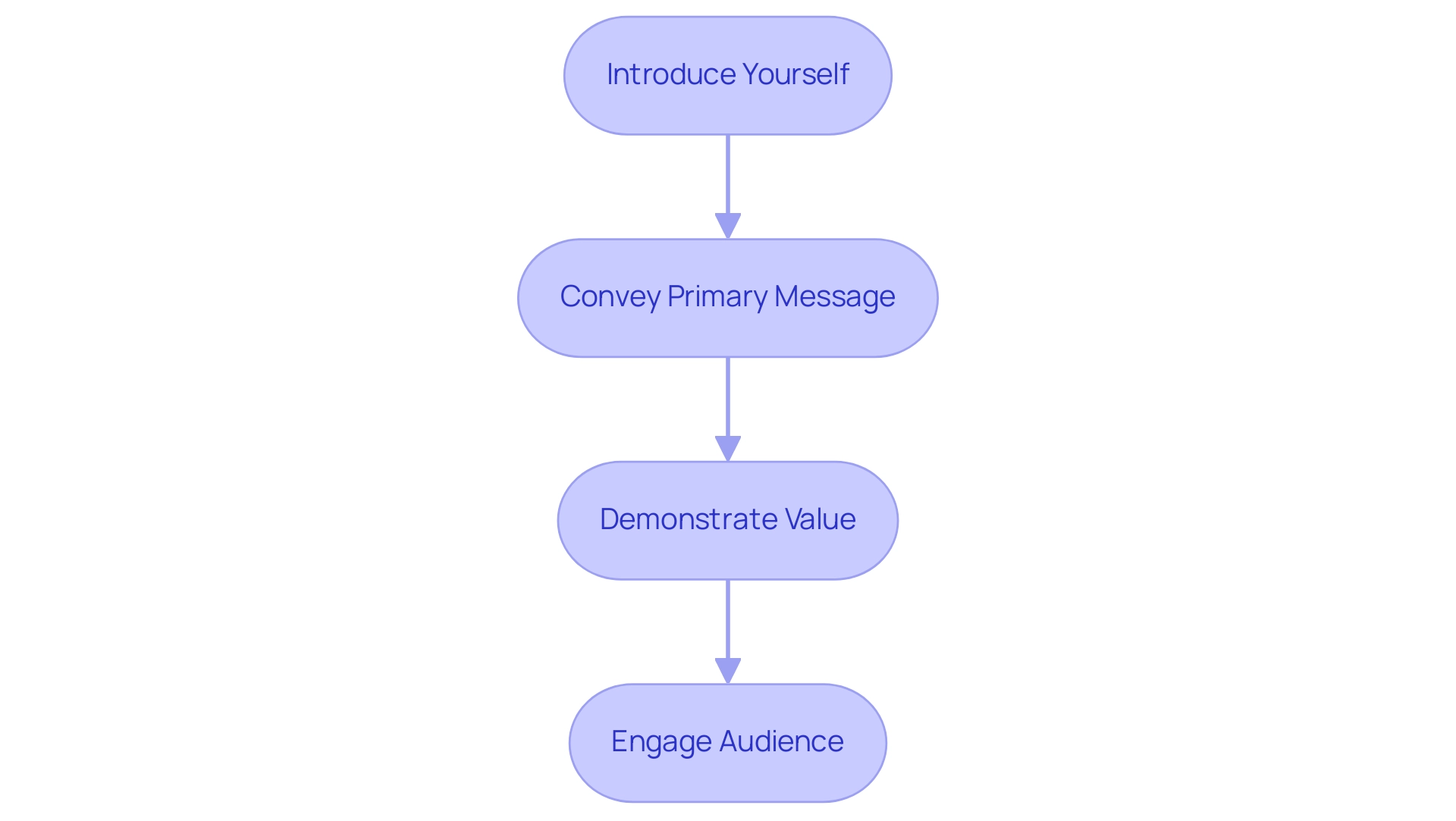
Key Elements of a Compelling Elevator Pitch
An effective elevator presentation is a powerful tool for entrepreneurs, and it should encompass several essential elements to resonate with your audience:
-
Introduction: Begin with a concise introduction that includes your name and the name of your business. This sets the stage for who you are and what you represent.
-
Problem Statement: Clearly articulate the specific problem your business addresses. This is crucial, as a well-defined problem statement captures attention and establishes relevance. Statistics indicate that a compelling problem statement can significantly enhance the effectiveness of your presentation, aligning with the priorities of potential investors. Solution: Describe your product or service and how it effectively resolves the identified problem. Highlighting the solution not only showcases your offering but also demonstrates its practical application in the market.
-
Unique Value Proposition: Explain what differentiates your offering from competitors. A strong unique value proposition is vital; it conveys why your solution is the best choice. The Entrepreneur’s Source exemplifies this with its comprehensive and personalized approach to career coaching, which is particularly beneficial for individuals navigating career transitions. Research shows that businesses with a clear unique value proposition can improve their efficiency by an additional 25% after several months, underscoring its importance in attracting interest.
-
Market Readiness: Incorporate the significance of the ‘Why Now?’ slide in your proposal. This slide, positioned between the Problem and Solution slides, articulates market readiness for your offering, which is a priority for many investors. A well-crafted ‘Why Now?’ slide can enhance your startup’s appeal by focusing on seizing market opportunities.
-
Call to Action: Conclude with a clear call to action, inviting your audience to engage further, whether through a follow-up meeting or additional discussions. This step is essential for fostering connections and advancing conversations.
-
Practical Advice: For small businesses, it’s important to specify the number of employees committed to a project to avoid intimidation. This practical detail can assist prospective investors in assessing the seriousness and ability of your team.
By integrating these elements into your entrepreneurship elevator pitch, you create a structured and persuasive narrative that effectively conveys your value proposition. Expert guidance highlights that a well-crafted proposal not only informs but also inspires action, making it a critical component of entrepreneurial success. Additionally, as Tom Eisenmann from Harvard Business School notes, it often takes presenting to 58 investors and holding 40 detailed meetings over 12 weeks to successfully close a seed round, highlighting the challenges entrepreneurs face in securing funding.
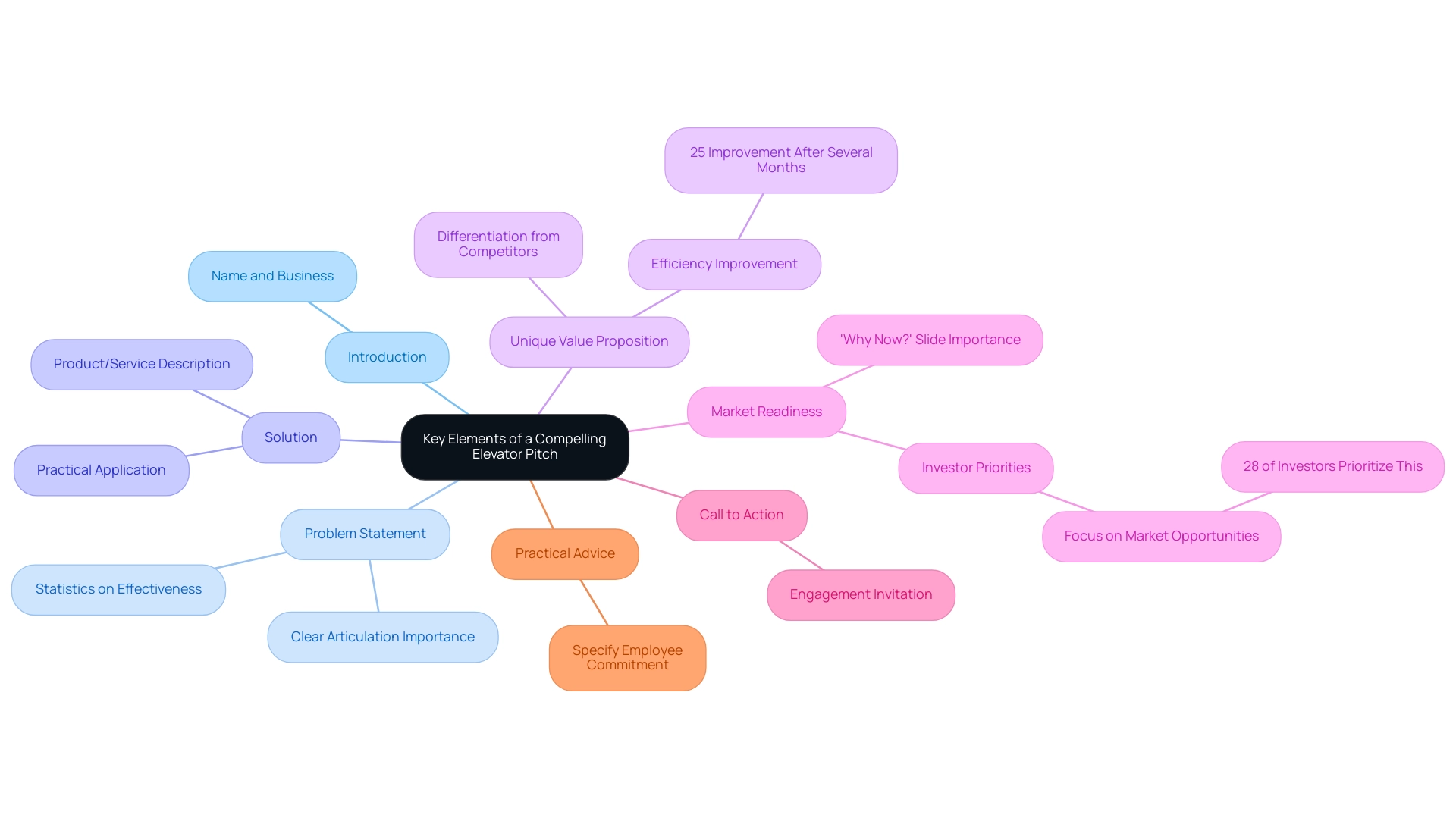
Identifying and Analyzing Your Audience
To effectively customize your entrepreneurship elevator pitch, it’s essential to begin by identifying your target group with care and intention. Here are some important steps to guide you:
-
Research: Understand your target group comprehensively, focusing on their interests, needs, and pain points. This foundational knowledge is crucial for crafting an entrepreneurship elevator pitch that truly resonates. We understand that navigating career transitions can be challenging, and insights from ‘Your Career 2.0: A Survival Guide for The Battered Career Syndrome and Investor Syndrome’ highlight the importance of knowing your stakeholders. This understanding can empower you to take control of your professional journey.
-
Segment: Organize your audience into distinct groups based on shared characteristics or goals. This thoughtful segmentation fosters more focused communication, ensuring that your proposal addresses the unique concerns of each group. By supporting both demand- and account-based marketing strategies, you enhance customer engagement, leading to greater financial freedom and personal agency, especially in a challenging job market.
-
Customize: Adapt your presentation to address the unique interests and challenges of each segment. Personalizing your entrepreneurship elevator pitch enhances its relevance and impact, significantly increasing the likelihood of a positive response. As Parnell Woodard, a Career Ownership Coach, wisely states, “This approach has made The Entrepreneur’s Source a trusted partner for those seeking to reinvent their professional lives.”
Statistics reveal that businesses engaging in consumer analysis see greater success in their marketing efforts. For instance, companies focusing on customer segmentation in their presentations experience significant improvements in engagement and conversion rates. Furthermore, a case study on social selling indicates that 78% of companies employing this strategy excel compared to those that do not, underscoring the importance of knowing your target market to achieve your business goals.
By thoroughly analyzing your audience, you can create a captivating entrepreneurship elevator pitch that not only captures attention but also fosters meaningful connections. This paves the way for successful entrepreneurial endeavors. To further enhance your journey, consider exploring ‘Your Career 2.0: A Survival Guide for The Battered Career Syndrome and Investor Syndrome’ as a vital resource for navigating these challenges and achieving business ownership. Remember, you are not alone in this journey, and we are here to support you every step of the way.
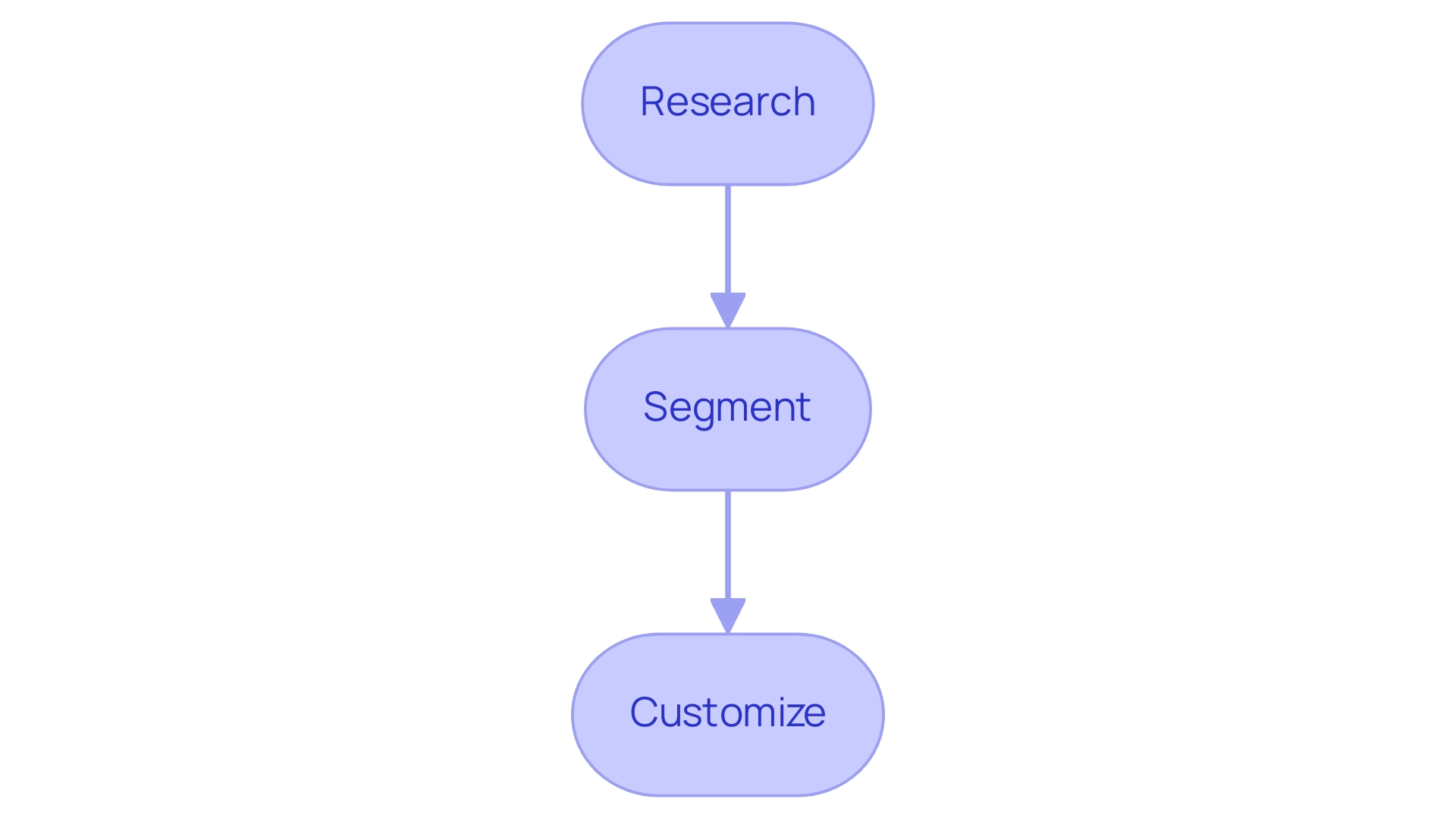
The Power of Storytelling in Your Pitch
Incorporating storytelling into your entrepreneurship elevator pitch can significantly enhance its effectiveness, especially for those navigating career transitions in a changing economy. How can you craft a compelling narrative that resonates deeply with your audience?
- Start with a Hook: Begin with an engaging anecdote or a thought-provoking question that immediately captures attention. This initial connection sets the tone for your entire presentation, reflecting your journey toward empowerment and financial independence.
- Connect with the Viewers: Share stories that resonate with their experiences or challenges. By aligning your narrative with their realities, you foster a sense of understanding and relatability, which is essential in a declining job market.
- Highlight the Journey: In your entrepreneurship elevator pitch, share your entrepreneurial journey, detailing the challenges you faced and the lessons learned along the way. This not only humanizes your proposal but also illustrates resilience and adaptability—qualities that are highly valued in business and crucial for those seeking to take control of their destiny.
- Conclude with Impact: End your story with a strong message that reinforces your value proposition. A powerful conclusion can leave a lasting impression and motivate your listeners to take action, emphasizing the importance of personal agency in achieving financial freedom.
Research indicates that storytelling can significantly enhance engagement in business communication. In fact, sales professionals who rehearse their presentations, incorporating storytelling techniques, are 65% more likely to close deals successfully compared to those who do not. By weaving storytelling into your presentation, you establish an emotional bond that resonates with your listeners, ultimately making your message more memorable and impactful.
As Parnell Woodard, a Career Ownership Coach, emphasizes, empowering clients to achieve their career goals is crucial, and storytelling plays a vital role in this process. Understanding your audience and crafting a clear message are essential components of effective storytelling in presentations, as highlighted in the case study ‘Key Elements of a Great Brand Story.’ This approach not only fosters emotional connections but also builds trust and enhances customer loyalty, contributing to the overall success of your proposal.
Furthermore, addressing the challenges of employability and the limitations of conventional career options is vital for those looking to control their own destiny and fund their longer, active life expectancy.
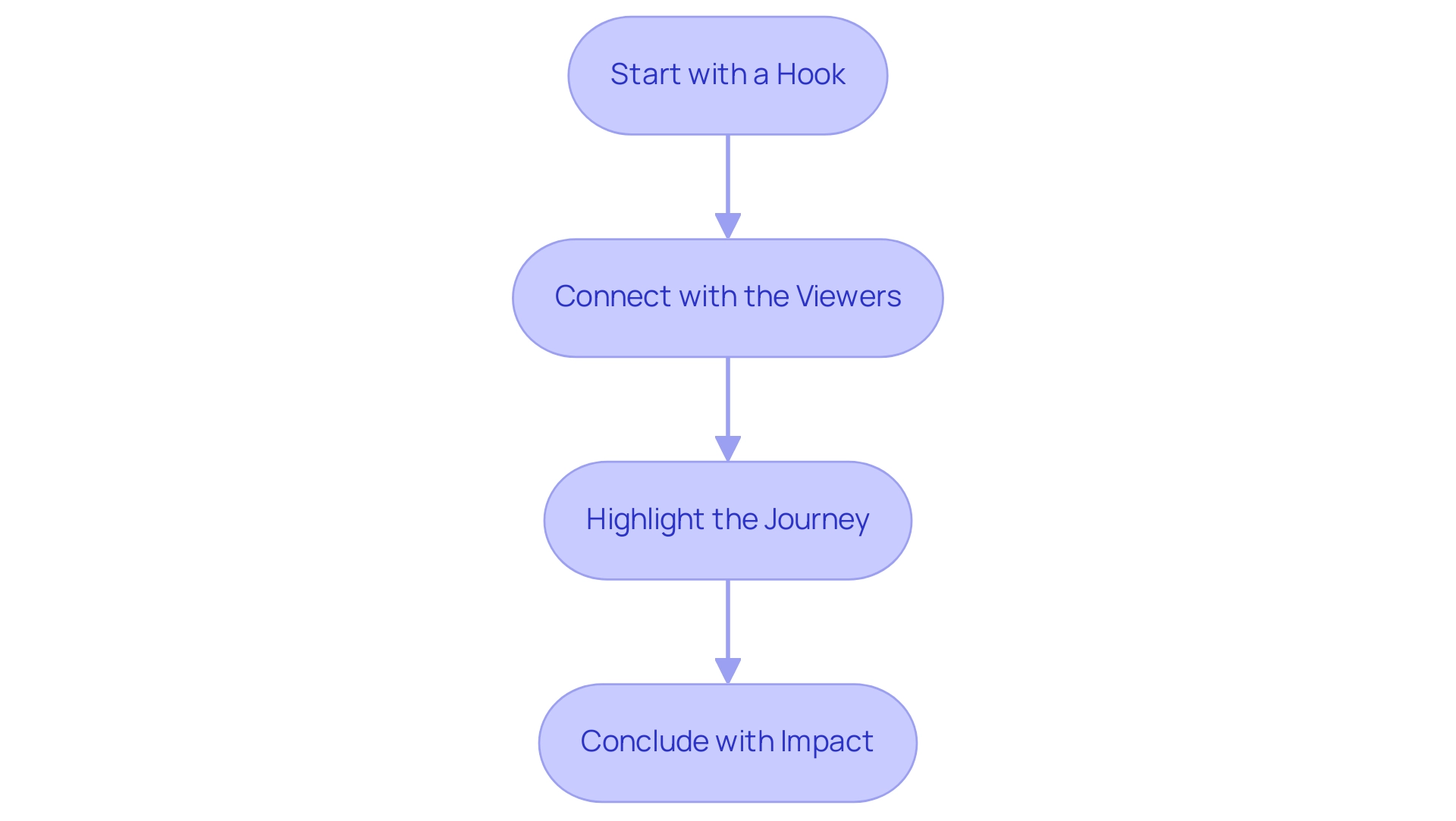
Delivering Your Elevator Pitch: Tips for Success
To deliver your elevator pitch successfully, consider these supportive strategies:
-
Practice: Rehearsing your presentation multiple times is crucial. We understand that consistent practice significantly enhances fluency and confidence, allowing you to present your ideas more effectively. The Entrepreneur’s Source has helped countless individuals evaluate their professional options, demonstrating how practice can elevate your pitch delivery. This is especially important in a challenging job market where conventional career paths may feel limited; articulating your value can truly set you apart.
-
Body Language: Your nonverbal cues are essential in communication. Maintaining eye contact, using open gestures, and adopting a confident posture can enhance engagement and convey your enthusiasm for your message. For example, a case study on overcoming communication barriers shows how positive body language fosters understanding and empathy, which is vital in any pitch. As Nick Morgan, a contributor to Psychology Today, wisely states, “If that unconscious mind operated in such a way as to cause you to naturally adopt a certain pose before you spoke and then remain open and closed to those listening while speaking, you wouldn’t have to think about it (consciously), and public speaking would be a little easier.” This insight is particularly relevant as you navigate your career transition and seek to build a supportive network.
-
Pace Yourself: Speaking clearly and at a moderate pace ensures your message is understood. This approach not only aids comprehension but also allows your audience to absorb what you present. In a world where jobs can feel fleeting, being articulate about your transferable skills can significantly enhance your employability and financial independence.
-
Engage: Encourage interaction by asking questions or inviting feedback. This approach not only makes your presentation more dynamic but also helps establish a connection with your audience. Engaging your audience can lead to new opportunities and partnerships, empowering you to take charge of your professional journey.
By focusing on these delivery techniques, you can greatly enhance the effectiveness of your presentation and leave a lasting positive impression. Remember, the way you present your ideas is just as important as the ideas themselves. The comprehensive and personalized approach of The Entrepreneur’s Source can further empower you in mastering these techniques, ensuring you achieve your career goals and navigate the challenges of a changing economy.
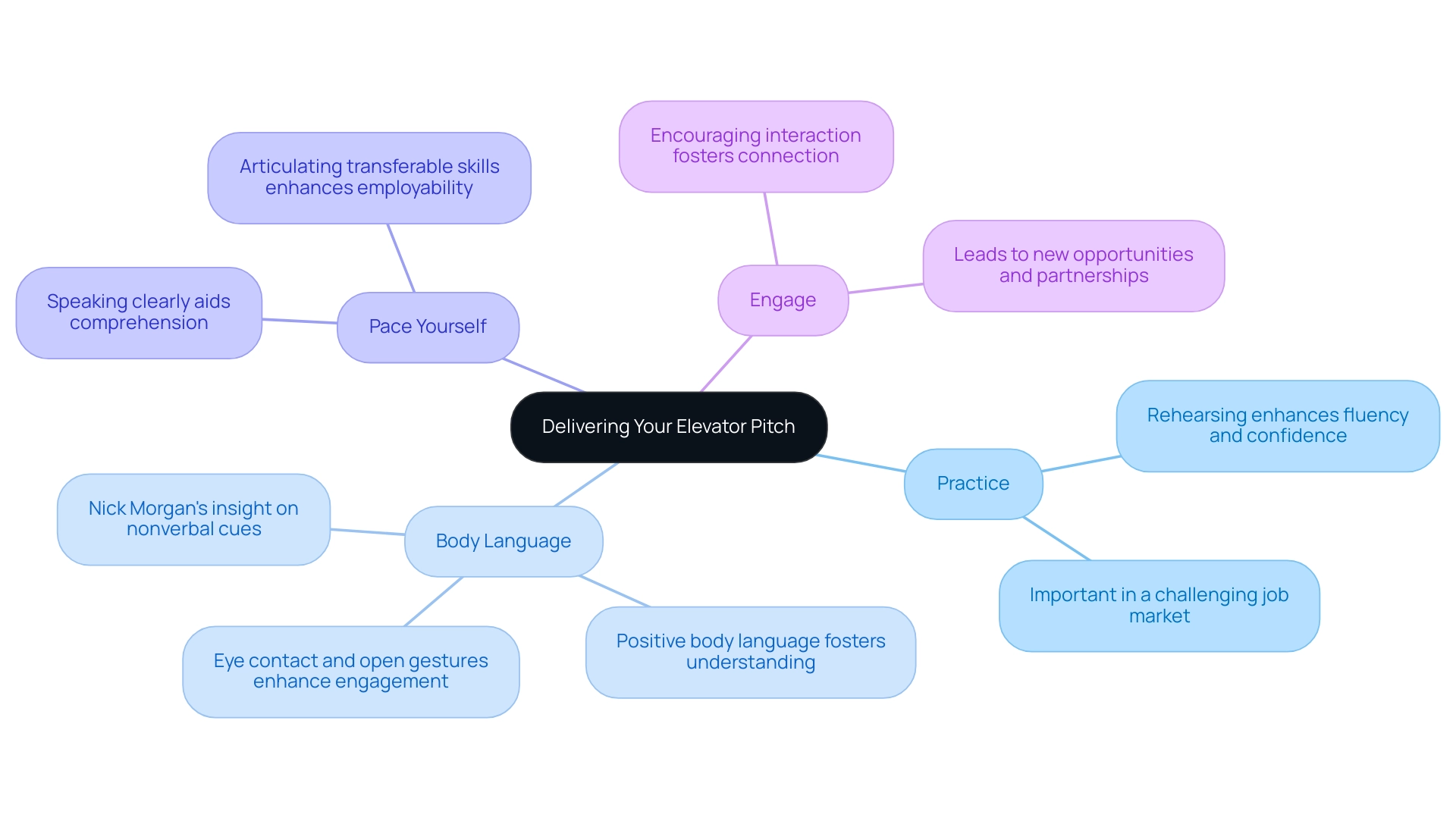
Avoiding Common Mistakes in Elevator Pitches
Crafting an effective elevator pitch can be daunting, but you are not alone. To help you avoid common pitfalls and connect with your audience, consider these nurturing strategies:
- Be Concise: Aim for brevity by keeping your presentation focused and direct. Studies suggest that presentations should optimally last no more than 30 seconds to keep listeners engaged.
- Avoid Jargon: Clear communication is crucial. We understand that using jargon can alienate your listeners and obscure your message. Simplifying your language enhances understanding and engagement, fostering a deeper connection.
- Don’t Overwhelm: Share only essential information to prevent confusion. A well-organized presentation should highlight your core message without inundating listeners with excessive details.
- Practice Active Listening: Pay attention to your audience’s reactions. This enables you to modify your tone in real-time, making it more pertinent and engaging.
Common errors in elevator presentations include being overly lengthy, pushy, or generic. In fact, statistics show that 70% of entrepreneurs struggle to connect with their audience due to these issues. Furthermore, ineffective presentations often stem from a lack of preparation, leading to missed opportunities.
The Entrepreneur’s Source has helped countless individuals evaluate their career options, emphasizing the importance of preparation and clarity in presentations. You deserve to feel confident in your pitch.
For instance, the Startup Storyteller Tool exemplifies how entrepreneurs can refine their narratives. By inputting their startup’s challenges, users can create engaging presentations that resonate with their listeners, ultimately saving time and enhancing clarity. This tool serves as a practical application of the strategies discussed, demonstrating how to effectively communicate your entrepreneurial vision.
Moreover, remember that your body language significantly impacts how your brief introduction is perceived. As Ketaki, a Personal Branding Guide, wisely states, ‘Your body language influences how your brief presentation is received by the audience.’ By avoiding these traps and utilizing these techniques, you can craft a more impactful and memorable entrepreneurship elevator pitch that effectively conveys your vision. You are capable of making meaningful connections, and with these strategies, you can truly shine.
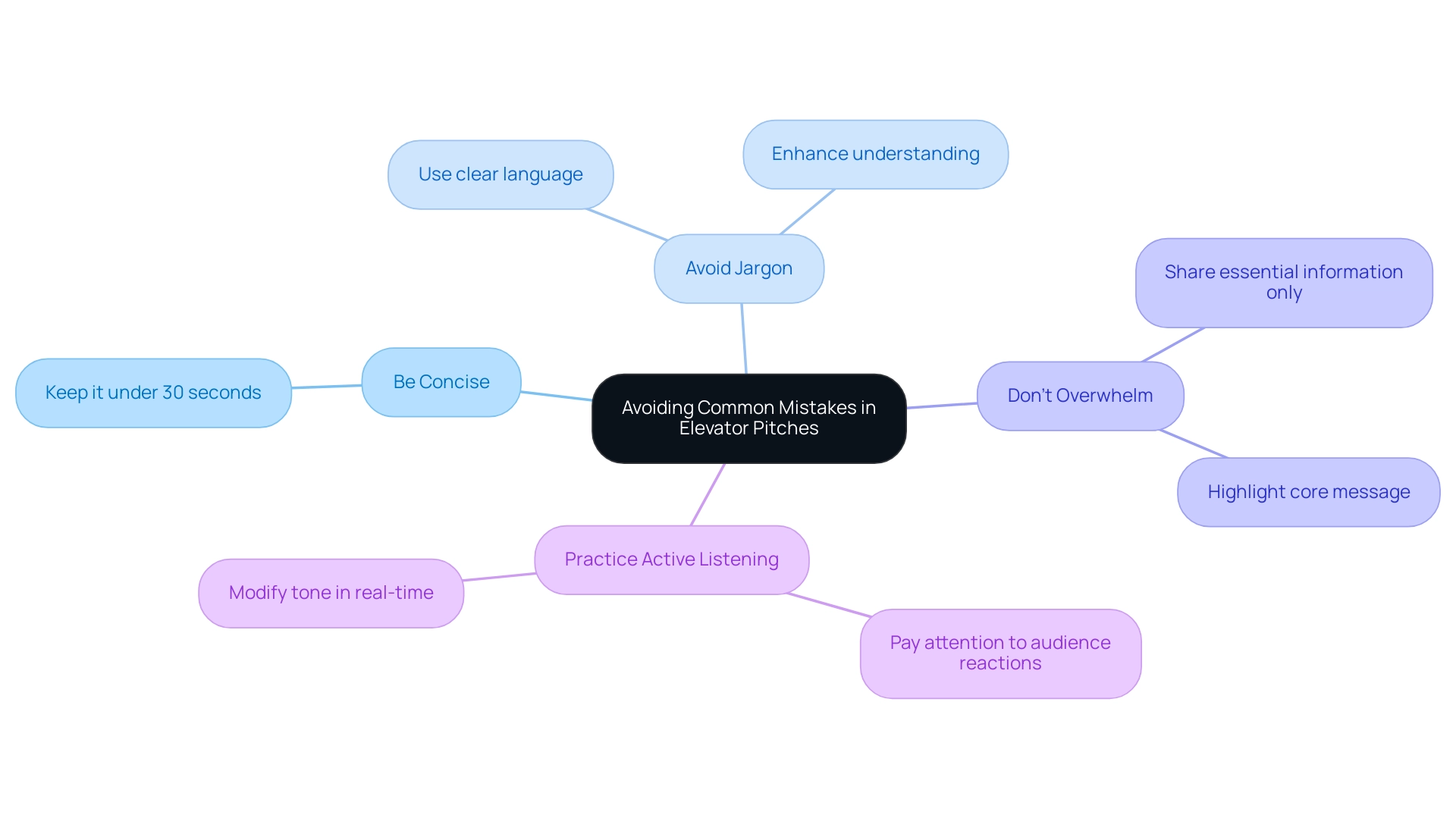
The Importance of Follow-Up After Your Pitch
After delivering your elevator pitch, it’s crucial to follow these steps to maximize your opportunities:
-
Send a Thank-You Note: A simple expression of gratitude can go a long way. We understand that taking the time to thank someone not only demonstrates appreciation for their time but also strengthens your professionalism. This is a key element of taking charge of your career, as emphasized in ‘Your Career 2.0: A Survival Guide for The Battered Career Syndrome and Investor Syndrome’ by Find Your Career 2.0 | Career Ownership Coach Parnell Woodard.
-
Recap Key Points: Briefly summarizing the main aspects of your presentation helps to reinforce your message and keeps it fresh in the listener’s mind. This is particularly important as studies indicate that 70% of employers utilize social media to evaluate potential employees. Your follow-up is a chance to solidify your presence. As Andrei Kurtuy, Co-Founder & Career Expert, notes, “70% of employers use social media to evaluate potential employees and vice versa.” This aligns with the urgency highlighted in ‘There is No Time Like the Present’ from ‘Your Career Revolution,’ where timely follow-ups can significantly influence your professional trajectory.
-
Suggest Next Steps: Proposing a follow-up meeting or call demonstrates initiative and keeps the momentum going. We recognize that this proactive approach is essential, especially considering that 49% of professionals cite lack of time as a barrier to networking. By taking charge of your networking efforts, you embody the principles of personal agency and financial freedom discussed in ‘Your Career 2.0.’
-
Stay Engaged: Keep the conversation alive by sharing relevant articles or updates related to your proposal. Engaging with your network can lead to fruitful discussions and opportunities. In fact, the shift towards online networking has shown that 40% of individuals prefer this method, highlighting the importance of maintaining connections in a digital landscape. This is particularly relevant in the context of navigating career challenges in today’s job market.
The COVID-19 pandemic significantly impacted business networking, leading to a decline in in-person interactions. Many professionals felt anxious about job loss and were hesitant to connect with others. However, companies pivoted to virtual events, resulting in a notable increase in organizations planning and investing in virtual networking opportunities.
Implementing a thoughtful follow-up strategy not only strengthens connections but also significantly increases the likelihood of achieving your goals. Case studies from ‘Your Career 2.0’ have shown that professionals who actively follow up after their entrepreneurship elevator pitch see a marked improvement in their networking outcomes, particularly in the wake of the pandemic. By staying connected and engaged, you position yourself as a valuable contact in your network, embodying the transformative journey outlined in your Career Revolution.
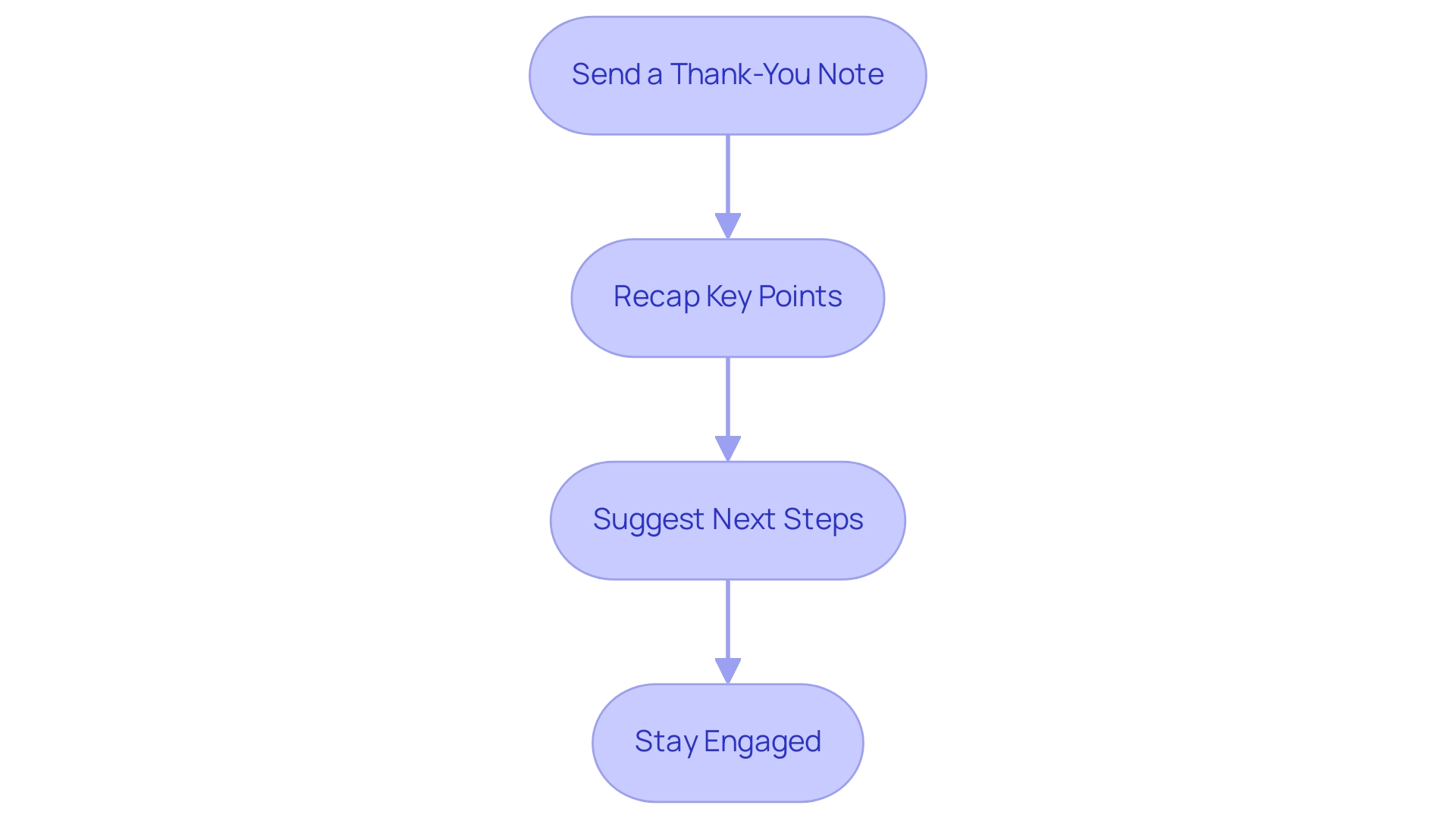
Conclusion
Mastering the entrepreneurship elevator pitch is not just important; it’s essential for navigating today’s competitive business landscape. We understand that conveying your ideas effectively can feel daunting, yet this concise narrative is your opportunity to capture the attention of investors, partners, and customers. A successful pitch hinges on key elements:
- A clear problem statement
- A compelling solution
- A unique value proposition—all articulated with confidence.
Incorporating storytelling into your pitch can profoundly enhance its impact, fostering emotional connections that resonate with your audience. Have you considered how tailoring your message to specific segments can increase its relevance? Effective delivery techniques—such as practicing your pitch, employing positive body language, and actively engaging your listeners—are vital for leaving a lasting impression.
Avoiding common pitfalls, like jargon and excessive details, is crucial for ensuring clarity and keeping your audience engaged. Remember, following up after your pitch with gratitude and a recap of key points not only reinforces your professionalism but also opens doors for future opportunities.
In summary, the entrepreneurship elevator pitch serves as a powerful communication tool and a strategic asset that can unlock new possibilities. By refining this skill, you can enhance your chances of success and take control of your career journey, leading to greater financial independence and personal fulfillment. You are not alone in this process; with dedication and practice, the potential for growth and networking is truly boundless.
Frequently Asked Questions
What is an entrepreneurship elevator pitch?
An entrepreneurship elevator pitch is a brief presentation lasting between 30 to 60 seconds that clearly expresses who you are, what you do, and why it matters. It aims to spark curiosity and encourage further dialogue about your business idea, product, or service.
Why is mastering the entrepreneurship elevator pitch important?
Mastering the elevator pitch is vital for entrepreneurs seeking to attract investors, partners, or clients. A well-crafted introduction can significantly increase interest, with studies showing a 30% rise in engagement from potential stakeholders when a clear value proposition is conveyed.
What are the key elements of an effective elevator pitch?
An effective elevator pitch should include: 1. Introduction: Your name and business name. 2. Problem Statement: A clear articulation of the specific problem your business addresses. 3. Solution: Description of your product or service and how it resolves the identified problem. 4. Unique Value Proposition: Explanation of what differentiates your offering from competitors. 5. Market Readiness: Importance of the ‘Why Now?’ slide to articulate market opportunities. 6. Call to Action: A clear invitation for further engagement or discussions.
How can storytelling enhance an elevator pitch?
Incorporating personal storytelling and emotional connections in an elevator pitch can make it more memorable and impactful, resonating deeply with audiences who are eager to reimagine their professional aspirations.
What role do learning experience platforms (LXP) play in refining elevator pitches?
Learning experience platforms offer valuable tools for personalized, skills-centered education, enabling entrepreneurs to refine their presentations through tailored feedback and resources that enhance their development process.
What are some proven strategies for improving networking outcomes through elevator pitches?
Strategies include adhering to a clear framework for presentations, such as introducing yourself, conveying a primary message, demonstrating value, and concluding with an engaging finish. Entrepreneurs who apply these strategies report significant improvements in networking outcomes.
What expert insights emphasize the necessity of a persuasive elevator pitch?
Experts stress that delivering a compelling elevator pitch can set entrepreneurs apart in a competitive market. For instance, Brad Feld highlights the importance of showing what you can do rather than just describing it.
How does a well-structured elevator pitch contribute to entrepreneurial success?
A well-structured elevator pitch not only informs but also inspires action, serving as a strategic asset that can unlock new opportunities and collaborations, thus enhancing the chances of success in today’s dynamic business environment.


